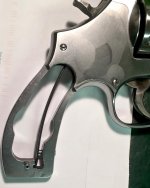andyo5
Member
My usual approach to reducing trigger pull has been to replace the stock rebound spring with a 14 lb Wolff version, and then to shorten the strain screw until I get close to an 8 lb DA trigger. I then may rejigger the rebound spring to achieve a 3 lb SA pull. These guns all shoot well, with Federal primers.
But my new 686-6 and new 629 Classic do not respond to this approach at all. Oddly, shortening the strain screw has no measurable effect (trigger pull gauge) unless you remove so much length that the single action sear doesn't always hold. Not acceptable for obvious reasons.
An alternative method is to use the Wolff Type I mainspring with a full length strain screw and a 14 or 15 lb rebound spring. It feels great in both SA and DA, but it will only set off Federal primers (tried it only on the 629) and won't fire Winchester primers even in single action.
Currently, I have both with factory mainspring, full length strain screw, and 14 or 15 lb. rebound spring. The reduced power rebound spring does help.
DA is off my scale (probably about 12/13 pounds) and SA is 3 pounds (good).
Since these guns are to be used for competition or carry, I'd like to stay around 9 lbs in DA and 3 lbs in SA.
I can't imagine what is different about these guns as compared to my 2005 era M625s or my M686-4. There must be some design differences, I just can't figure out what they are.
Any suggestions?
But my new 686-6 and new 629 Classic do not respond to this approach at all. Oddly, shortening the strain screw has no measurable effect (trigger pull gauge) unless you remove so much length that the single action sear doesn't always hold. Not acceptable for obvious reasons.
An alternative method is to use the Wolff Type I mainspring with a full length strain screw and a 14 or 15 lb rebound spring. It feels great in both SA and DA, but it will only set off Federal primers (tried it only on the 629) and won't fire Winchester primers even in single action.
Currently, I have both with factory mainspring, full length strain screw, and 14 or 15 lb. rebound spring. The reduced power rebound spring does help.
DA is off my scale (probably about 12/13 pounds) and SA is 3 pounds (good).
Since these guns are to be used for competition or carry, I'd like to stay around 9 lbs in DA and 3 lbs in SA.
I can't imagine what is different about these guns as compared to my 2005 era M625s or my M686-4. There must be some design differences, I just can't figure out what they are.
Any suggestions?


